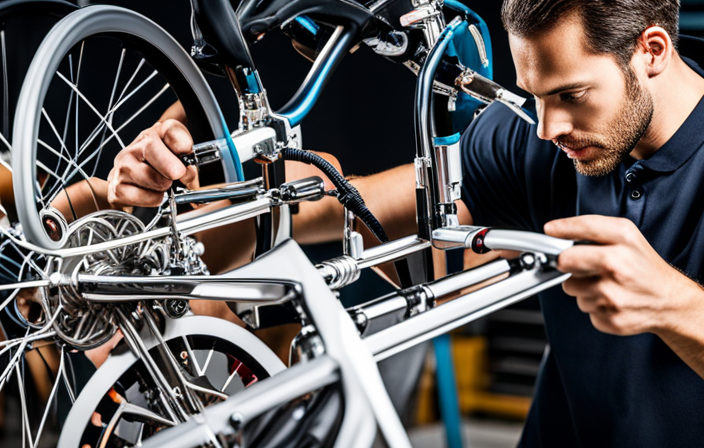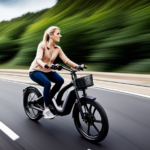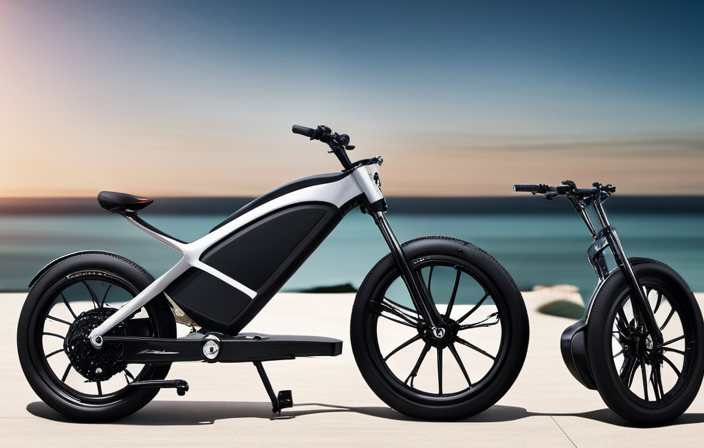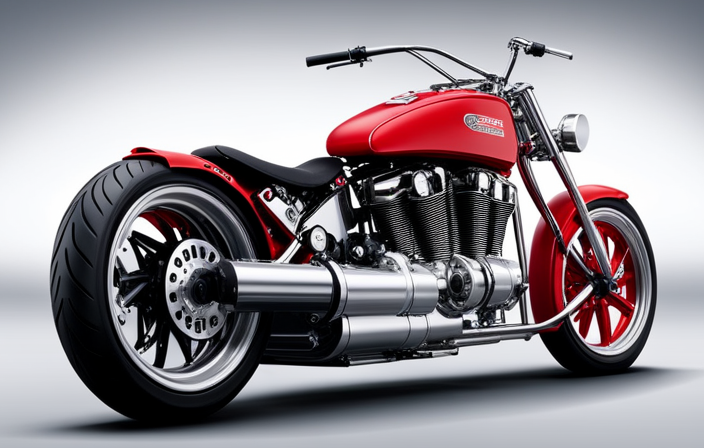Unlocking the speed limit on your electric bike is like peeling away the constraints that hold back your potential. With the right knowledge and tools, you can unleash the full power and exhilaration of your electric bike.
In this article, I will guide you through the process of unlocking the speed limit on your electric bike, ensuring you ride responsibly and safely while enjoying the thrill of increased speed.
Let’s dive into the technical details and explore the possibilities that lie ahead.
Key Takeaways
- Modifying the speed limit on an electric bike can have severe legal repercussions.
- E-bikes are subject to specific regulations and restrictions, and altering the speed limit may require additional licensing, insurance, and registration.
- Exceeding the legal speed limit compromises safety and can result in accidents or injuries.
- It is important to ride responsibly, respect local laws and regulations, and promote community awareness and ethical riding.
Understand the Regulations and Safety Considerations
Before you start modifying your electric bike, it’s important to understand the regulations and safety considerations. Exceeding the speed limits on an electric bike can pose serious dangers, both for the rider and other people on the road.
It is crucial to be aware of the speed limits in your area and adhere to them for everyone’s safety. Additionally, exceeding the speed limits can have a negative impact on the battery life of your electric bike. The motor will have to work harder to maintain higher speeds, which can drain the battery faster and reduce its overall lifespan.
Therefore, it is essential to balance the desire for increased speed with the need to maintain safety and preserve the longevity of your electric bike’s battery.
Moving on to the next section, let’s determine the type of speed limit restriction on your electric bike.
Determine the Type of Speed Limit Restriction on Your Electric Bike
To determine the type of restriction on your e-bike, you need to identify the specific settings that control its maximum velocity.
There are different types of speed limit restrictions that manufacturers may implement on electric bikes. Some e-bikes have a physical speed limiter, which is a mechanical device that physically prevents the bike from exceeding a certain speed.
Others have a software-based speed limiter, which is controlled through the bike’s computer system. Troubleshooting speed limit issues involves accessing the bike’s settings and checking the speed limit parameters. This may require referring to the bike’s user manual or contacting the manufacturer for guidance.
Understanding the type of speed limit restriction on your e-bike is crucial for unlocking its speed potential safely. Researching the manufacturer’s guidelines and restrictions will provide further insight into the specific steps to take for modifying the speed limit.
Research the Manufacturer’s Guidelines and Restrictions
Check out the manufacturer’s guidelines and restrictions to gain a better understanding of how to modify your e-bike’s speed settings. It is crucial to adhere to the manufacturer’s guidelines to ensure the safety and optimal performance of your electric bike.
The manufacturer’s guidelines will provide specific information on the speed limit restriction of your e-bike and any modifications that can be made to unlock the speed limit. These guidelines may include instructions on adjusting the settings through the bike’s display or control panel, or they may recommend specific software or firmware updates to unlock the speed limit.
By following the manufacturer’s guidelines, you can ensure that you are making the necessary modifications to your e-bike safely and effectively.
After reviewing the manufacturer’s guidelines and restrictions, the next step is to check for software or firmware updates from the manufacturer that may allow you to unlock the speed limit.
Check for Software or Firmware Updates from the Manufacturer
Make sure to see if the manufacturer has released any software or firmware updates that could potentially enhance the performance of your e-bike. This is a crucial step in unlocking the speed limit of your electric bike as manufacturers often release updates that address speed limit restrictions. By installing these updates, you can potentially remove or increase the speed limit imposed on your e-bike.
Consider the following potential risks and benefits when checking for software or firmware updates:
-
Risks:
-
Warranty void: Installing unofficial updates may void your warranty.
-
Compatibility issues: Updates may not be compatible with all e-bike models.
-
Unintended consequences: Updating the software may have unintended effects on other functionalities of your e-bike.
-
Benefits:
-
Increased speed: Updates may remove or increase the speed limit, allowing for faster rides.
-
Enhanced performance: Updates can optimize the motor and battery efficiency.
-
Improved safety features: Updates may introduce additional safety features to protect riders.
Considering the potential risks and benefits of updating your e-bike’s software or firmware, it is important to weigh your options before proceeding with the next step of considering a speed limit removal kit.
Consider Using a Speed Limit Removal Kit
Consider utilizing a speed limit removal kit to maximize the potential of your e-bike. These kits are designed to override the built-in speed restrictions of electric bikes, allowing you to reach higher speeds. However, it is important to weigh the pros and cons before making a decision.
Pros:
- Increased speed: With the speed limit removed, you can experience faster rides and cover more ground in less time.
- Enhanced performance: Removing the speed limit can improve the overall performance of your bike, providing a smoother and more exhilarating riding experience.
Cons:
- Safety concerns: Riding at higher speeds can increase the risk of accidents, especially if you are not used to handling the bike at faster speeds.
- Legal considerations: It is important to check the local regulations regarding speed limits for electric bikes. Removing the speed limit may result in legal consequences if you are caught exceeding the allowed speed.
When considering using a speed limit removal kit, it is crucial to consult with a professional bike mechanic or electric bike specialist. They can provide guidance on the installation process and ensure that it is done safely and within the legal limits.
Consult with a Professional Bike Mechanic or Electric Bike Specialist
Seek the advice of a professional mechanic or specialist to ensure the proper installation and safety of your e-bike modification. When it comes to electric bike tuning and DIY speed limit removal, it is crucial to consult with an expert who has experience with these modifications.
A professional bike mechanic or electric bike specialist can provide valuable insight and guidance throughout the process. They can help you understand the intricacies of your specific e-bike model and advise you on the best approach to unlocking the speed limit. Additionally, they can ensure that the modification is done correctly and safely, minimizing the risk of damage or accidents.
By seeking professional guidance, you can be confident that your speed limit removal is performed accurately and in compliance with the manufacturer’s guidelines. Once you have consulted with a professional, you can then proceed to follow the instructions provided with the speed limit removal kit.
Follow the Instructions Provided with the Speed Limit Removal Kit
Start by carefully reading and following the instructions included in the kit for removing the speed limit on your e-bike. It is important to take safety precautions and understand the legal implications before proceeding. The instructions will provide you with a step-by-step process to safely remove the speed limit and unlock the full potential of your electric bike.
To help you visualize the process, here is a table outlining the main steps involved:
| Step | Description | Safety Precautions |
|---|---|---|
| 1 | Gather all necessary tools and equipment | Wear protective gloves and goggles |
| 2 | Disconnect the battery from the bike | Ensure the bike is turned off and power is disconnected |
| 3 | Locate the speed limit removal module | Handle with care to avoid damaging any components |
By following these instructions and taking the necessary safety precautions, you can successfully remove the speed limit on your electric bike. Once completed, you will be ready to adjust the speed settings on your electric bike’s controller.
Adjust the Speed Settings on Your Electric Bike’s Controller
To customize your riding experience, you can easily adjust the speed settings on your e-bike’s controller. However, before making any changes, it is important to take some safety precautions to avoid potential risks.
Firstly, ensure that your e-bike is turned off and the battery is disconnected to prevent any accidental activation. Next, carefully read the user manual provided with your electric bike to understand the specific instructions for adjusting the speed settings.
Additionally, it is recommended to wear appropriate safety gear, such as a helmet and protective clothing, while working on your e-bike.
Once you have made the necessary adjustments, it is crucial to test the bike’s performance in a safe and controlled environment to ensure that it operates smoothly and meets your desired speed requirements.
Test the Bike’s Performance in a Safe and Controlled Environment
To ensure that the adjustments made to the speed settings on your electric bike’s controller have been successful, it is crucial to test the bike’s performance in a safe and controlled environment. This step is essential to ensure that the bike is functioning optimally and that the desired speed limit has been unlocked.
When conducting performance testing, it is important to prioritize safety measures. Always wear appropriate safety gear, such as a helmet and protective clothing. Find a suitable location, preferably a flat and open area, to test the bike’s speed and acceleration.
Start by gradually increasing the throttle and observing the bike’s response. Pay close attention to any vibrations, unusual sounds, or handling issues.
During the testing process, take note of the bike’s speed at different throttle positions and assess its overall performance. This information will be helpful in monitoring your electric bike’s speed and performance in the subsequent section.
Monitor Your Electric Bike’s Speed and Performance
Keep an eye on how fast and smoothly your e-bike is running to ensure it is performing at its best. Monitoring your electric bike’s speed and performance is essential for efficient electric bike maintenance. One crucial aspect to consider is choosing the right electric bike battery. The battery plays a significant role in the bike’s speed and overall performance. Opting for a high-quality battery with a sufficient capacity will ensure optimal output. To help you understand the importance of monitoring, here is a comparison table showcasing the difference between a low-capacity battery and a high-capacity battery:
| Battery Capacity | Speed | Range |
|---|---|---|
| Low | Slower | Shorter |
| High | Faster | Longer |
By continuously monitoring your electric bike’s speed and performance and choosing the right battery, you can maximize its capabilities. However, it’s crucial to be aware of the legal implications and consequences of altering the speed limit of your electric bike.
[SUBSEQUENT SECTION: ‘Be aware of the legal implications and consequences’]Be Aware of the Legal Implications and Consequences
It’s important to understand the legal consequences and implications of modifying your e-bike’s speed. Modifying an electric bike to exceed the speed limit can have severe legal repercussions.
In many jurisdictions, e-bikes are classified as bicycles and are subject to specific regulations and restrictions. Altering the speed limit of your electric bike may result in it being reclassified as a motorcycle or moped, which would require additional licensing, insurance, and registration.
Furthermore, exceeding the legal speed limit can be dangerous and compromise the safety of both the rider and others on the road. It’s crucial to consider safety considerations such as braking distance and maneuverability when riding at higher speeds.
Therefore, it is imperative to ride responsibly and respect local laws and regulations to ensure the safety of yourself and others on the road.
Ride Responsibly and Respect Local Laws and Regulations
Respecting local laws and regulations is essential when riding an e-bike. It not only ensures your safety but also promotes community awareness and ethical riding.
Before setting off, familiarize yourself with the specific laws and regulations governing e-bike usage in your area. Pay attention to speed limits, designated bike lanes, and any restrictions on where you can ride. By obeying these rules, you demonstrate your commitment to being a responsible and considerate rider.
This not only protects you but also fosters positive relationships with pedestrians, motorists, and other cyclists in your community. Moreover, adhering to local laws and regulations helps create a safer and more harmonious environment for everyone. By respecting these guidelines, you can enjoy the many benefits of e-bike riding while maintaining a positive image for the e-bike community.
Moving forward, it is important to maintain your electric bike properly to ensure safety and performance.
Maintain Your Electric Bike Properly to Ensure Safety and Performance
To ensure your safety and optimal performance, it’s important to properly maintain your e-bike. Here are three essential electric bike maintenance tips that will help you keep your bike in top shape:
-
Regularly check and inflate the tires: Proper tire pressure is crucial for a smooth and safe ride. Inspect the tires for any signs of wear or damage, and inflate them to the recommended pressure specified by the manufacturer.
-
Keep the battery charged and clean: The battery is the heart of your electric bike. Make sure to charge it regularly and avoid complete discharge. Additionally, keep the battery clean and dry, as moisture can cause damage.
-
Lubricate the chain and gears: Keeping the chain and gears properly lubricated will ensure a smooth and efficient ride. Use a high-quality lubricant and apply it regularly, wiping off any excess.
By following these electric bike maintenance tips and taking safety precautions, you can enjoy a reliable and safe ride.
Now, let’s consider the risks and benefits of unlocking the speed limit.
Consider the Risks and Benefits of Unlocking the Speed Limit
Considering the risks and benefits of increasing the maximum velocity on your e-bike is important for making an informed decision. Weighing the risks, such as potential loss of control, increased likelihood of accidents, and violation of local traffic laws, is crucial.
However, there are also advantages to unlocking the speed limit. It can provide a thrilling experience, especially for riders seeking more excitement and a faster commute. Additionally, it may reduce travel time and increase the overall efficiency of your e-bike.
It is essential to consider your riding skills, experience, and the conditions in which you will be riding when deciding to unlock the speed limit. By evaluating the risks and benefits, you can make an educated choice that aligns with your preferences.
So, get ready to enjoy the thrill of increased speed on your electric bike!
Enjoy the Thrill of Increased Speed on Your Electric Bike!
After carefully considering the risks and benefits of unlocking the speed limit on your electric bike, it’s time to dive into the thrilling world of increased speed! As an avid electric bike enthusiast, I can attest to the excitement that comes with riding at higher speeds. But before you embark on this exhilarating journey, it’s crucial to keep safety considerations in mind.
Here are three important factors to remember:
-
Enhanced control: With increased speed, it’s essential to have full control over your bike. Be sure to practice proper braking techniques and familiarize yourself with the bike’s handling at higher speeds.
-
Protective gear: As speed increases, the risk of accidents also rises. Invest in high-quality protective gear such as a helmet, knee and elbow pads, and reflective clothing to ensure your safety on the road.
-
Road conditions: Pay close attention to road conditions and potential hazards. Higher speeds require a heightened awareness of your surroundings, including other vehicles, pedestrians, and road obstacles.
By considering these safety factors, you can fully enjoy the exhilaration of increased speed on your electric bike while ensuring a safe and enjoyable ride.
Frequently Asked Questions
Are there any legal consequences for unlocking the speed limit on an electric bike?
Unlocking the speed limit on an electric bike can have legal consequences and safety concerns. It is important to note that tampering with the speed limit may violate laws and regulations, potentially leading to fines, penalties, and increased risk of accidents.
Is it necessary to consult with a professional bike mechanic or electric bike specialist before attempting to unlock the speed limit?
Consulting a professional bike mechanic or electric bike specialist is crucial before attempting to unlock the speed limit. Their expertise ensures safe and proper modifications, minimizing the risk of damaging the bike or facing legal consequences.
What are the potential risks associated with unlocking the speed limit on an electric bike?
Unlocking the speed limit on an electric bike can have serious risks and consequences. It may lead to loss of control, increased chances of accidents, damage to the bike, legal issues, and voiding of warranty.
Can unlocking the speed limit affect the safety and performance of the electric bike?
Unlocking the speed limit on an electric bike can have significant safety concerns and impact its performance. It may compromise the bike’s stability, reduce its braking ability, and increase the risk of accidents due to the increased speed.
What are the benefits of unlocking the speed limit on an electric bike?
Unlocking the speed limit on an electric bike has several benefits. It allows for increased top speed and faster acceleration, providing a thrilling riding experience. However, it is crucial to follow safety guidelines and ensure proper modifications to avoid any potential risks.
Conclusion
In conclusion, unlocking the speed limit on your electric bike requires careful consideration and adherence to regulations and safety guidelines. By understanding the type of speed limit restriction and consulting the manufacturer’s guidelines, you can ensure a safe and responsible approach.
Additionally, checking for software updates and considering a speed limit removal kit can further enhance your electric bike’s performance. However, it is essential to weigh the risks and benefits of unlocking the speed limit and always ride responsibly, respecting local laws.
Unlocking the speed limit on your electric bike can be as thrilling as a bird soaring through the sky, but it is crucial to prioritize safety and maintain your bike diligently.
















